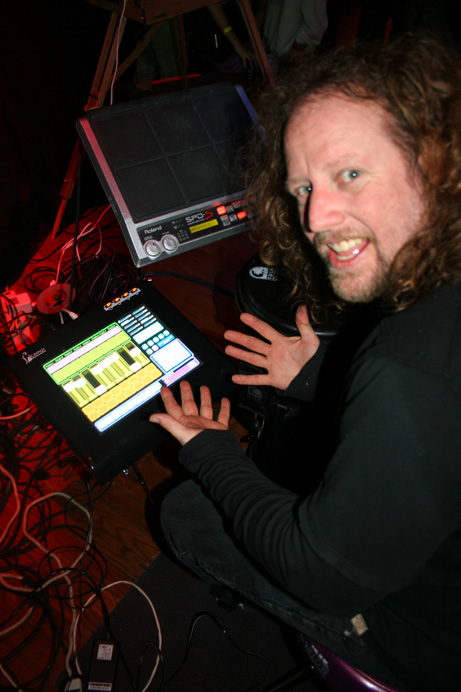|
Jason Hann was born in Miami, Florida. His father is a musician and his mother Colombian and with that background he ended up with an education in music and a great grounding in all sorts of styles including global rhythms and contemporary rock and rap.
“I learned to play drums and percussion from watching my dad’s band after school,” he remembers. “I eventually took lessons and started playing professionally at clubs when I was 12. I made a habit of learning traditional rhythms from other cultures outside of school while constantly staying in touch with modern pop music styles.”
Eventually Hann made his way over to California and started playing with some legendary names…
“I started getting studio and touring dates in Los Angeles with artists such as Dr. Dre, Rickie Lee Jones, Isaac Hayes, Loreena McKinnet, and The String Cheese Incident. From The String Cheese Incident came my current band EOTO which consists of me and Michael Travis. We’re a duo that plays all improvised live electronic music (Breakbeat, Drum n Bass, IDM, Glitch, House, and so on).”
Jason is very much of the opinion that technology shouldn’t get in the way of music making and he has embraced Jazzmutant’s Lemur as part of this philosophy.
“I believe that what you’re hearing in your head should flow as seamlessly as possible to the audience,” he says. “I think some people like to be gear heads and watch the technical aspects of a performance, but as a musician playing live club dance music, the greatest sense of achievement is when you’ve inspired and exhausted the dancing audience like no other has before, and they let you know it.”
As part of Jason’s attempts to achieve this on stage he needs a lot of MIDI control. During an EOTO live set, he used to use a simple trigger system mapped to Ableton Live, but it was not without its drawbacks. “I had so many things assigned to them, it was hard to keep track of what was ‘on’ and ‘off’! I originally saw the Monome [light-based trigger system] which was attractive because of the light indicators, but had no faders or knobs. After YouTube-ing it, I eventually came across the Lemur, and I was immediately convinced that it was going to be my key to an enhanced performance.”
Jason has been on tour since his Lemur purchase so has had the chance to test it extensively in the live arena, and also plans to incorporate it into his studio set-up when he finished his current round of live dates. As well as triggering, the Lemur offers Hann some valuable feedback as his show progresses…
“In EOTO me and Travis use the same computer to run all of our gear through,” he says, “but the computer is over by Travis so I can’t see what’s going on. I programmed the Lemur so that I can tell whenever he’s putting a certain effect on my drums or electronic percussion. I also programmed it
so that I can remotely control Ableton to ‘punch in’ and ‘punch out’ of record when I’m stacking my percussion parts live. I also created faders so that I can control those individual tracks (eight in total) and I’ve programmed a bunch of input and output effects to affect both those tracks and also our two master outs that we send to the front of house.”
So how is Jason’s live experience now that he has his Lemur fully incorporated into his act?
“My flow on stage is much easier now,” he says. “EOTO is an all-improv electronica project, so pacing and timing are crucial to produce a set that sounds like it was pre-recorded when, in fact, we’re making up every note on the spot. When I didn’t have indicators to tell me what was going on, I’d have to guess which were the last effects I had on, and which was the last track I recorded to. There would be a few times a night where I found myself confused and wondering why things were sounding the way that they did, and I would have to troubleshoot without a whole lot of confidence of what the status of the effects and tracks were. That was happening while I was trying to play drums at the same time!”
“The Lemur has made that process so immediate that I can get back to thinking about the music, instead of the technical aspects during a set. It does everything I need it to do right now. I don’t think I’ve come close to pushing the boundaries of it.”
And having such a fine looking piece of technology on stage is not without its advantages, as Jason reveals…
“When people see the Lemur, they freak out! Very few people know about it in the US so it’s a pretty amazing piece of gear to have on the scene. It will be nice when it becomes more commonplace so that you can trade more ideas of its possibilities. Right now it’s great that it’s both unique and the ultimate solution for my remote control needs when playing live.”
Jason’s future plans involve getting further into the guts of Lemur (“the scripting language is a whole other thing. I want to get deeper into that, but I need time off the road to dig in, in a serious way”), as well as taking the unit out on more international dates. “We are continuing to grow our fan base, will tour more internationally, and stay open to any possibilities the future may bring.”
|

|




